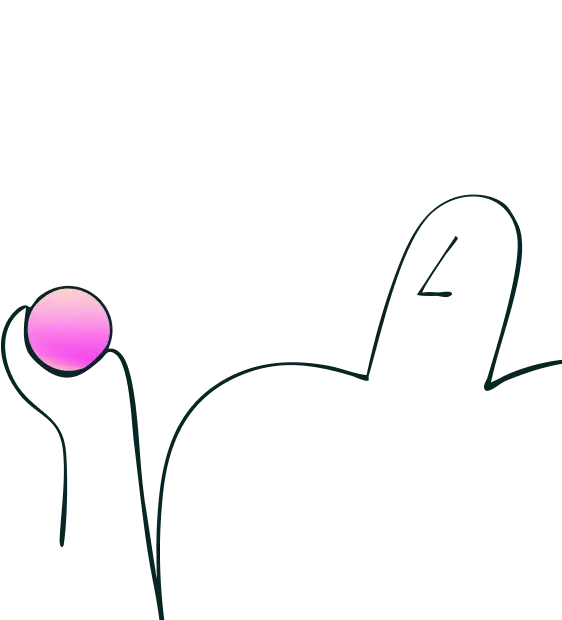30 May 2025
|15 min
SaaS UX design
Discover the benefits of good UX design for SaaS products and find tips and best practices for designing user-centered experiences that will enhance your SaaS products.

High product adoption rates and self-sustaining growth is every SaaS team's dream.
How do you accomplish this? It all starts with thoughtful SaaS UX design.
Throughout this article, you’ll find helpful examples and best practices for UX designers working in SaaS. Experienced folks in product design and user research also weigh in on the importance of good UX design in SaaS.
Whether you're announcing your first product launch or gearing for the release of your tenth feature, keep reading to learn how to create functional, helpful, and enjoyable user experiences in SaaS.
What is SaaS UX design?
Software-as-a-service, or SaaS, is a delivery model for software that enables users and customers to access applications via the internet. This eliminates the need to install physical media.
UX design for SaaS products helps users accomplish their goals and have a seamless, intuitive experience while using the software. It's worth noting that it's not just about impressing users with great visuals but also delighting them with how easily and efficiently they can get things done with your software.
Good UX design in SaaS is critical to a product's success because it can directly impact whether users continue to use your product or abandon it for one of your competitors. For example, a good checkout design can improve the conversion rate of an e-commerce site by 35%.
The following section outlines the benefits of great UX design in SaaS and how it can help your company succeed in today's competitive market.
Why is good UX design important for SaaS products?
Before we explore UX design examples and best practices, let’s take a quick look at how SaaS companies of all shapes and sizes can benefit from good UX design.
1. Reduce churn rates
Churn is the rate at which paying customers cancel their recurring subscriptions. It’s often measured as a percentage.
Reducing churn rates is one of the most significant benefits of good SaaS UX design. Your paying customers won't have second thoughts canceling their accounts if they find your product challenging to navigate or if it doesn't meet their expectations.
Meanwhile, a SaaS application with an intuitive and helpful user experience is more likely to increase customer engagement and retention.
For example, an easy-to-follow user engagement flow for new users will encourage them to use your software often. "Customers don't churn what they use. Get them to use the product and win them over by validating their reasons to buy. Canva did a fantastic job of this when I signed up, and made me feel like a graphic designer though I'm not," shares Mike Lieberman, CEO and Founder of Square 2 Marketing.
2. Increased customer acquisition and retention
Customer acquisition refers to getting new customers, while customer retention is about keeping these customers from switching to the competition.
A well-designed, intuitive SaaS interface helps build trust. As a result, potential customers are more likely to try your product, and existing customers are more likely to renew their subscriptions.
A survey by Treasure Data and Forbes Insights further supports that good UX in SaaS can help you get more customers and improve conversion rates. Their key findings include the following:
Most consumers (74%) are influenced by their experiences when making purchasing decisions.
A significant percentage of executives (83%) face the risk of revenue and market share loss due to poor customer experience.
3. Improve user engagement and boost brand loyalty
Mok Jee Jin, a product designer at Piktochart shares:
"It's often easy to overlook the fact that we are interacting with another person on the other side of the screen. Great experiences are designed with the interest of their users in mind. Whether it is providing ease of interaction, anticipating what user needs, or being delightful, SaaS products designed with UX design principles in mind can greatly improve the engagement between the user and the app."
When customers have a positive experience while engaging with your software, they’re likely to continue using it and even recommend it to others. This often leads to a loyal customer base which can be a significant competitive advantage for SaaS companies.
4. Empower users to be their best
User-centered design in SaaS can help your users feel empowered to complete a task, making them feel more confident while using your product. On the other hand, poor UX makes people grumpy because it hinders them from doing their job.
According to Alicia Cressal, Senior Growth Designer at Parabol, bad UX increases (rather than decreases) the time it takes to do a task.
"For example, in college I worked as a cashier at a hardware store. A woman who was a retired teacher started in the same role at the same time as me. The Point of Sale (POS) system was really awful to work with – it looked like it came from a floppy disk. The retired teacher struggled to use the system even when she was using it day-to-day. The UX just didn't make sense and it was preventing my colleague from performing her job well. The technology was making her worse at her job rather than better and that is never the goal," explains Alicia.
5. Make your product stand out in a crowded market
Finally, SaaS teams who develop products with good UX design in mind not only meet their customers' needs, but also gain a competitive advantage in the marketplace.
A product with a great user experience is more likely to be recommended by satisfied customers, and it can help establish your software as a leader in the industry. With so many SaaS products available, a well-designed product can be the difference between success and failure.
Best practices and tips for SaaS UX design
While designing helpful and user-centered experiences for SaaS might initially seem daunting, there are plenty of tools that can help you deliver better user experiences. Lyssna is a good example. It is the go-to remote user testing platform for design teams who want to create intuitive and delightful experiences.
As a UI/UX designer working in SaaS, you can also use the following tips and best practices as a checklist for your next projects.
1. Start with why through UX research and testing
User research and testing is a key part of the design process. When done well, user research helps you discover what your users need, how they use your product, and what they think about it.
"Always ask why someone needs something, and then ask why again. Get as close to the root of the problem as you can," recommends Alicia.
The best way to start your user research is by asking yourself some questions:
What do users want? How do they feel when using our product? How could we improve their experience with a feature or interaction?
What are our customers doing right now in their current state of mind? Are there any patterns that emerge when we look at our competitor's customer journeys?
"Every design is a hypothesis about a market, needs, solution, and relationship. What should we design? For whom? Why? How well did we do? These are the questions that guide our research activities. Our researchers carefully align user needs and goals with the core value delivered through our products," explains Eric Mahlstedt, former Global Head of User Research at IBM.
2. Aim for simplicity
When designing a SaaS product, keep in mind that users are often busy and in a hurry, and they don’t want to spend too much time trying to figure out how to use your product. For this reason, it makes sense to aim for simplicity.
What does simplicity look like in SaaS products?
It could mean avoiding unnecessary features, providing clear and concise instructions, and using familiar design patterns that users are already comfortable with.
"Simplicity in design isn't just about the minimal colors you use or the whitespace you include," writes Euphemia Wong, UX designer at Google. "It's about going deep into your user's minds and using that understanding to design a product that rids itself of inconsequential elements."
One great example of keeping it simple in UX design is Loom's video recording interface. With just a single click, users can easily record and share videos without any complicated setup or confusing options. The interface is clean and intuitive, with clear instructions and minimal distractions, making it easy for users to focus on their primary goal – recording a video.
3. Keep your registration process short and sweet
Your product registration process can make or break your user acquisition efforts.
First, users are often pressed for time and have limited patience, so a lengthy or complicated registration process can be a major turn-off.
Second, some users are hesitant to provide too much information upfront, so it's important to only ask for the essential details needed to get them started.
For these reasons, keeping your registration process short and simple makes sense. How?
Minimize the number of form fields, avoid unnecessary questions, and provide clear instructions and error messages.
Another benefit to keeping your product's registration process short and sweet is you reduce friction and improve the chances of your users completing the process and becoming paying customers.
Jasper AI is a great example of a SaaS company implementing a simple registration process. It only requires a user's name, email, and password. The two additional questions are clear and straightforward and can be completed in seconds.
Plus, they offer the option to sign up using Google, eliminating the need for users to create a new account altogether.
4. Communicate your product's value with straightforward, interactive onboarding
Onboarding introduces new users to your product and guides them through its features and functionality. A robust onboarding process can improve user engagement, reduce churn, and increase customer satisfaction.
A well thought out onboarding experience should help users understand how to use your product and achieve their goals more quickly. You can accomplish this through interactive walkthroughs, tooltips, and product tours, highlighting key features and explaining how they work.
For example, Notion takes a user-friendly approach to onboarding by not overwhelming first-time users with a complex dashboard. Instead, the platform introduces them to its core features through a simple, interactive tutorial.
Their "Get Started" page features a fully functional checklist that includes simple instructions like "Type ‘/’ for slash commands." This hands-on approach allows users to learn by doing, enabling them to understand how the product works and how to access its core value with ease.
High-contrast tooltips also appear when users hover over specific page elements, providing additional instructions as they navigate the interface. This helpful onboarding add-on also encourages users to explore the platform more.
5. Refine your information architecture
In SaaS products, information architecture is the organization and structure of information within your software.
Clear navigation menus, intuitive labeling systems, and grouping related information are examples of information architecture done right.
Through user testing methods like card sorting, you can identify areas where your information architecture can be improved and make changes accordingly.
One example of a SaaS product with refined information architecture is Asana. Asana has a clear and intuitive interface, making it easy for users to navigate and access the information they need. Its information architecture is well-organized, with tasks, projects, and teams clearly separated into different sections.
Users can easily create and manage tasks, assign them to specific team members, and track their progress. The platform also includes features such as calendars, timelines, and dashboards, which provide users with a high-level overview of their projects.
It's also worth noting that Asana's robust search functionality lets users quickly find specific tasks, projects, or team members.
6. Collaborate with stakeholders and get buy-in for user research
Stakeholders are individuals or groups vested in the product's success, such as executives, investors, or even your users.
Getting their input and feedback early in the design process is important. This helps ensure the product meets their needs and expectations, and aligns with business goals.
"User experience outcomes improve when UX is a team activity," writes Susan Farrell, Principal UX Researcher at mmhmm. She recommends the following steps to motivate stakeholders to participate in your user research activities:
Schedule collaboration regularly. It shouldn’t just be a one-time event.
Make user research and testing participation easy.
Evangelize user research and educate everyone in the team about its benefits.
Align your research goals with business goals if possible.
Share your processes, methods, and deliverables as much as possible.
Increase the visibility of your design artefacts, such as user journey maps, user task flows, and prototypes.
Level up your SaaS UX design skills with user research and testing
Thoughtful and data-driven UX design is a critical component of successful SaaS products. It can help reduce churn, increase customer acquisition and retention, boost user engagement and brand loyalty, empower users to be their best, and make your product gain a competitive edge.
Great UX in SaaS products happens when you prioritize user research and user testing throughout the design process. It doesn't have to be complicated if you pick the right tool for the job. Lyssna allows you to design surveys, run prototype tests, and more in one platform.
Elevate your research practice
Join over 320,000+ marketers, designers, researchers, and product leaders who use Lyssna to make data-driven decisions.
Frequently asked questions about SaaS UX design
--
Kai has been creating content for healthcare, design, and SaaS brands for over a decade. She also manages content (like a digital librarian of sorts). Hiking in nature, lap swimming, books, tea, and cats are some of her favorite things. Check out her digital nook or connect with her on LinkedIn.
You may also like these articles


Try for free today
Join over 320,000+ marketers, designers, researchers, and product leaders who use Lyssna to make data-driven decisions.
No credit card required





